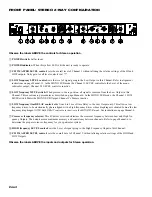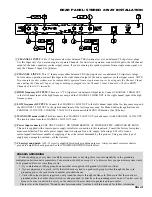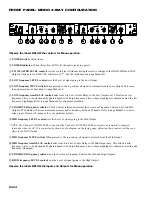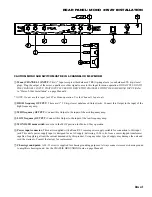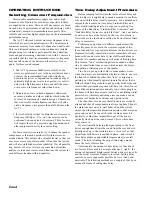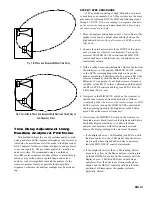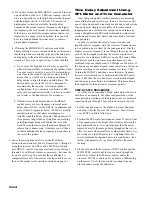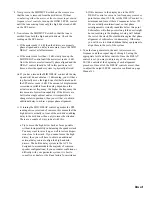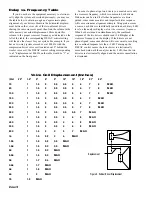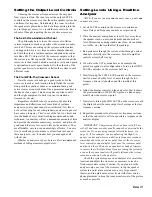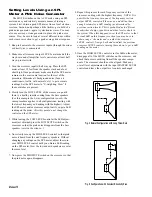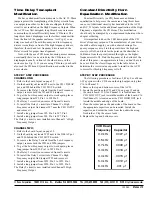
Manual-11
Setting the Output Level Controls
Choosing the crossover frequencies was the easy part.
Now it gets real fun. The idea is to set the output LEVEL
controls on the crossover so that the entire speaker system has
a uniform, flat response. Unfortunately, the room in which
the speakers are placed has a habit of always getting into the
act, so things get messy. As a result there seems to be two
schools of thought regarding the use of active crossovers.
The Set-lt-Once-And-Glue-lt School
The philosophy here is to use the crossover to flatten
system response as much as possible without room acoustics
involved. This means setting up the system outside (unless
you happen to have a very large anechoic chamber handy)
and with the aid of a realtime analyzer and pink noise source
(ala Rane RA 27), adjust all of the crossover outputs so that
the system is as flat as possible. Once the system is tuned, the
crossover is then locked behind a security cover (posted guard
is optional) and never again touched. It is then the job of the
system equalizer(s) to normalize or flatten the system to each
different room.
The Fix-lt-With-The-Crossover School
Here the crossover knobs get a good workout, for the
crossover is used at each location to help flatten the system
along with the equalizer. Some even maintain that a good
active crossover can work alone like a parametric equalizer in
the hands of an expert. This does require experience, skill,
and the right equipment to back it up (not to mention a
licensed set of ears).
Regardless of which school you profess, the absolute
importance and effectiveness of some kind of realtime
analyzer in your system cannot be overstressed! No, this is
not a callous plug for our other products; analyzers in general
have come a long way. They’re out of the lab (i.e. closet) and
into the hands of every smart working musician and sound
technician. An analyzer will save tremendous amounts of time
and provide the absolute consistency, accuracy, and plain old
good sound that very few ears on this earth can deliver. They
are affordable, easy to use and amazingly effective. You owe
it to yourself and your audience to at least look into one of
these analyzers—you’ll wonder how you managed at all
without one.
Whether by analyzer or by ear, here are a few recommended
methods of setting crossover output Levels.
Setting Levels Using a Realtime
Analyzer
NOTE: If you are running two channels, tune up only one
channel at a time.
1. Set all LEVEL controls on the crossover to minimum;
leave Delay and Frequency controls as set previously.
2. Place the analyzer microphone at least 15 feet away from
the speaker stack, on axis (dead ahead) and about chest
level. Minimize any background noise (fans, air condition-
ers, traffic, etc.) that could affect the readings.
3. Run pink noise through the system, either through a mixer
channel or directly into the crossover. Turn all amplifier
controls at least half way up.
4. We will use the 3-Way mode here as an example: the
procedure applies to all configurations. Turn up the INPUT
LEVEL control(s) on the crossover half way.
5. Slowly turn up the LOW LEVEL control on the crossover,
until you hear a healthy level of noise through the low
frequency drivers (it should sound like rumble at this
point).
6. Adjust the display controls on the analyzer so that it shows
the greatest number of 0dB LED’s (green on Rane equip-
ment) below the crossover point.
7. Now slowly turn up the MID LEVEL on the crossover until
the display shows the same output level average as the low
frequency section.
8. Repeat this procedure for all crossover frequency sections,
so that the end result is as flat as possible a response on the
analyzer display.
IMPORTANT: Compression driver or horn roll-off, bass
roll-off, and room acoustic usually cannot be corrected by the
crossover. If you are using constant directivity horns, see
page 13. If, for example, you are adjusting the High Fre-
quency control and observe a decline in frequency response
somewhat above the crossover point, then set the crossover
level control for equal display level near the crossover point
and leave it there. Then use an equalizer or bank of tweeters
to correct the roll-off problem. If you are tuning the system in
a room, the room acoustics will greatly influence the system
response, as shown by the analyzer.
Check the system response on an analyzer at several other
locations and adjust the crossover as necessary to reach a
fixed compromise setting if desired. If you plan to use the
analyzer only once to set the crossover, set up the speaker
system in a quiet place outside or in a very large concert
theater, and run pink noise at low levels with closer micro-
phone placement to keep the room acoustics out of the picture
as much as possible.


